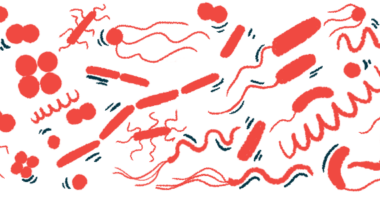Changing abundance of gut bacteria may lead to axSpA in IBD patients
Emerging evidence suggests a link between axSpA and IBD

Changes in the abundance of a bacteria called Escherichia_Shigella within the digestive tract of people with inflammatory bowel disease (IBD) may be related to the development of axial spondyloarthritis (axSpA), a new study revealed.
Among the IBD patients, 1 out of every 5 had an axSpA diagnosis, and half lived with chronic back pain. Apart from genetic risk factors related to axSpA in some IBD patients, no noticeable differences were seen between IBD patients with and without axSpA.
Identifying shared inflammatory pathways between alteration in gut microbes and inflammation in the joints “could revolutionize therapeutic approaches for axSpA,” wrote researchers in the study, “Clinical features and fecal microbiota characteristics of patients with both ulcerative colitis and axial spondyloarthritis,” which was published in the journal BMC Gastroenterology.
axSpA is a group of inflammatory diseases that mainly affects joints in the spine, pelvis, and chest. Ankylosing spondylitis is an axSpA subtype characterized by inflammation of the joints that connect the pelvis with the base of the spine.
Emerging evidence suggests a link between axSpA and IBD, a group of inflammatory disorders affecting the tissue of the digestive tract. Ulcerative colitis (UC) is an IBD subtype marked by inflammatory sores along the lining of the large intestine and rectum, and Crohn’s disease is associated with inflammation across the entire digestive tract, but mainly in the small intestine.
Half of asSpA patients have gut inflammation
axSpA can occur in up to 25% of IBD patients, while about half of axSpA patients experience gut inflammation. It has been suggested that the movement of immune cells from the gut to the joints and/or changes in gut microbes, called dysbiosis, may explain these findings.
According to researchers in China, however, “few data have been reported on the fecal flora structure in patients with IBD-axSpA.”
Therefore, the team analyzed the gut bacteria in fecal samples collected from 73 patients with ulcerative colitis, of whom 14 (19.2%) had axSpA and 37 (50.7%) had chronic back pain.
Almost half of the axSpA patients (42.9%) carried HLA-B27 variants, the strongest genetic risk factor linked to ankylosing spondylitis. More patients with axSpA had markedly higher levels of CRP, a blood marker that reflects ongoing inflammation in the body, than those without axSpA.
The two groups were similar in terms of sex, body fat content, smoking history, IBD severity and onset time, and medication history.
Fecal samples were assessed by 16S ribosomal DNA sequencing. Using this approach, different bacterial species present in a sample can be identified and classified.
Data analysis showed no differences in alpha diversity between the two groups, meaning the diversity of bacteria within individual samples collected from IBD patients with and without axSpA were similar.
In contrast, when samples from the two groups were compared against each other, to assess beta diversity, the microbial populations with axSpA patients were significantly distinct from those without axSpA.
The two groups showed differences in bacteria at the phylum level. The abundance of roteobacteria was significantly higher among axSpA patients, while that of Firmicutes was significantly lower than in IBD patients without axSpA.
xSpA patients had significantly higher proportions of Escherichia_Shigella
Looking at the genus levels, which are groups of closely related bacterial species and strains, xSpA patients had significantly higher proportions of Escherichia_Shigella and lower proportions of Faecalibacterium than those without xSpA.
Consistently, statistical analysis demonstrated that the relative abundance of Escherichia_Shigella is a likely indicator of axSpA, and Faecalibacterium is an indicator of no axSpA among these patients.
The team noted that a member of the Escherichia_Shigella genus called adherent-invasive Escherichia coli, carries an enzyme that has been shown to generate pro-inflammatory metabolites in mouse models infected with bacteria from patients with both Crohn’s and inflammation in the spine and joints.
Lastly, the researchers conducted a Kyoto Encyclopedia of Genes and Genomes pathway analysis, which examines the biological pathways associated with genetically identified microbial groups. Data showed the metabolism of fatty acids and antioxidant molecules was more active, or upregulated, in the bacteria within axSpA compared with non-axSpA patients.
“These significantly different metabolic pathways may help clarify the specific pathological [disease-related] mechanisms by which gut flora affect UC-axSpA,” the researchers wrote.
“Changes in the relative abundances of Escherichia_Shigella may be related to axSpA incidence,” the team concluded. “Based on the findings from this preliminary study, we are currently conducting a multiple-center study to recruit more qualified IBD patients who have extraintestinal manifestations.”







